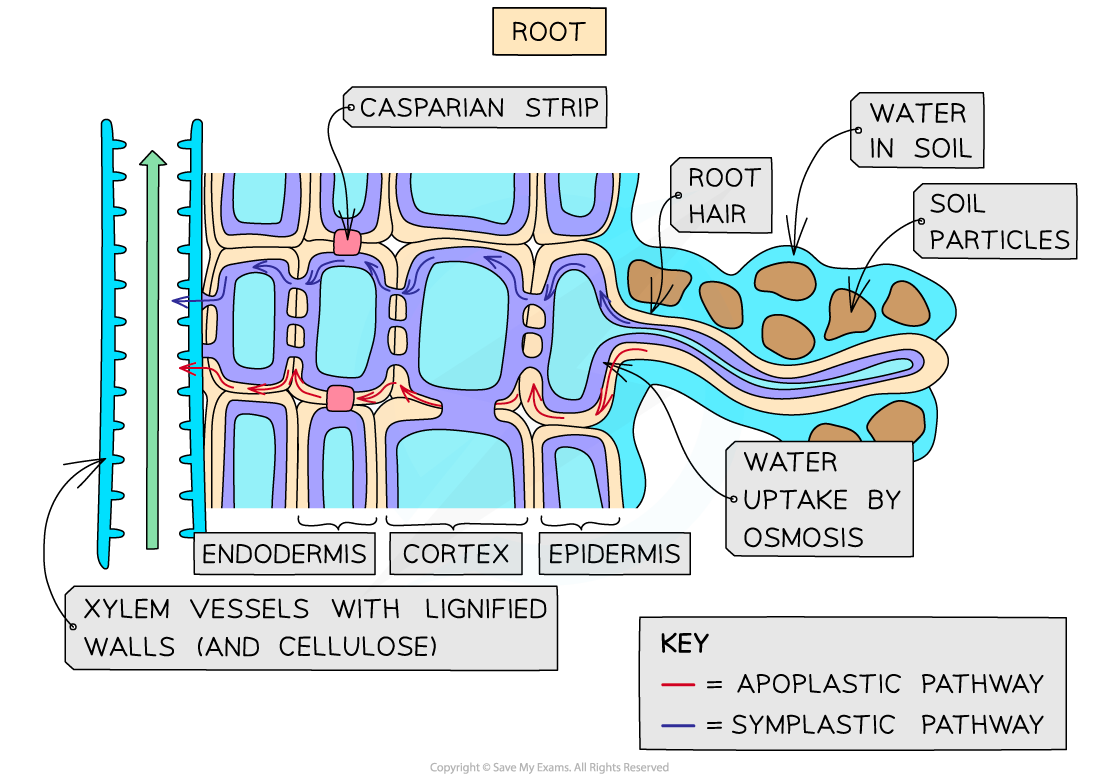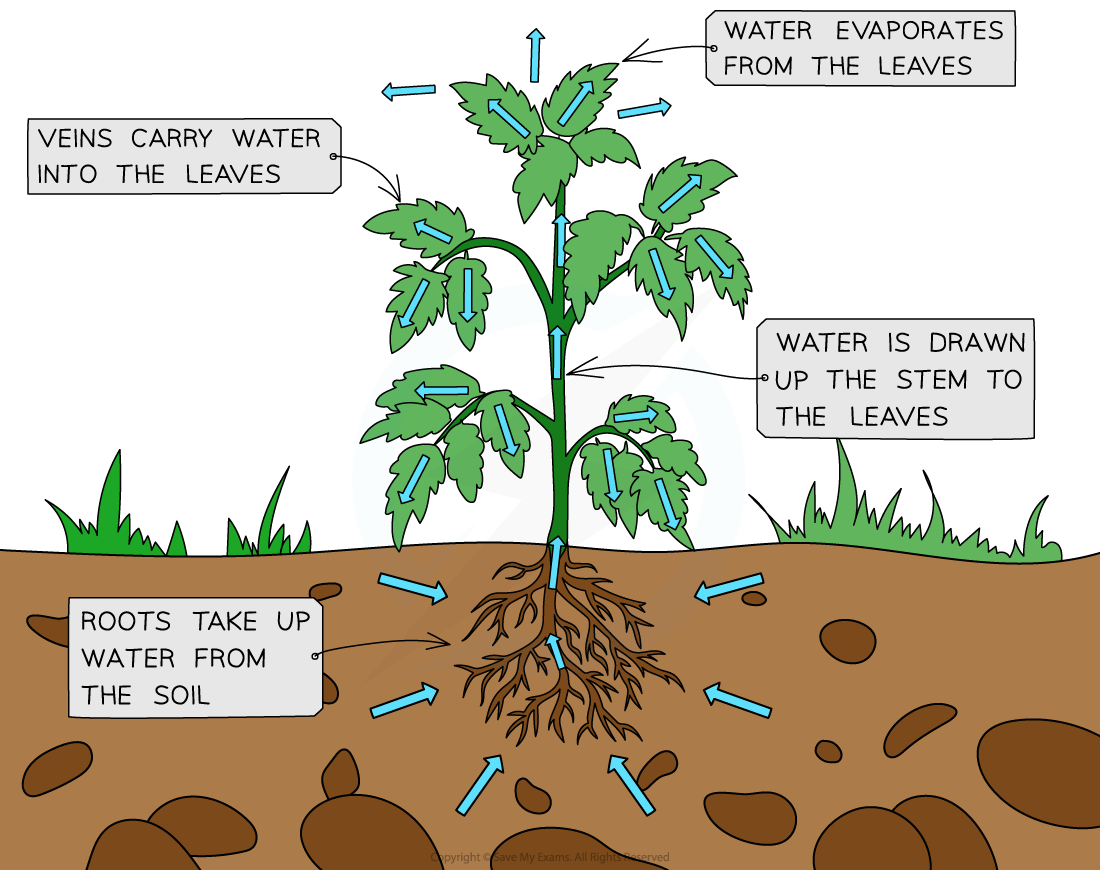Active Transport of Minerals in the Roots
- Within a plant, mineral ions are dissolved in water and transported in the xylem vessels
- Mineral ions needed by plants include nitrates, phosphates, and potassium ions
- Plant roots are responsible for the uptake of both water and mineral ions
- Root hair cells increase the available surface area for these processes
- The uptake of water is a passive process and occurs by osmosis as a result of the active transport of mineral ions into root cells
- Mineral ion uptake raises the solute concentration, or osmolarity of the root cells, causing water to move from an area of lower osmolarity in the soil to an area of higher osmolarity inside the root cells
Mineral ion uptake
- The soil surrounding root cells contains low concentrations of mineral ions in relation to the root cell contents, so several mechanisms are required to maintain an adequate supply of mineral ions to roots
- Mineral ions are actively transported into root cells by the action of specific transporter proteins in their cell surface membranes
- These proteins are sometimes known as protein pumps
- Note that active transport acts against a concentration gradient, so mineral ions are transported from an area of relatively low concentration in the soil to an area of relatively high concentration inside the root cells
- The movement of water in the surrounding soil and into the spaces within the cell walls of the root cells brings mineral ions into contact with their specific pump proteins
- Note that this is not referring to the movement of water by osmosis, but to the flow of water that results e.g. when it rains and water flows through the soil
- Some plants have a mutualistic relationship with soil fungi in which the fungus grows on, and sometimes into, the roots of the plant; the fungi cells spread out into the surrounding soil and absorbs mineral ions that the plant’s roots may not be able to access, passing them on to the plant
- In return the plant provides the fungus with sugars
- Mineral ions are actively transported into root cells by the action of specific transporter proteins in their cell surface membranes
Replacing Losses from Transpiration
- Plants transport water from roots to leaves to replace losses from transpiration
- Water needs to move across the root, up the stem, and across the leaves
Water movement across the root
- There is more than one pathway that water and dissolved minerals can take as they move across the central region of the root, known as the root cortex
- Apoplastic, or apoplast, pathway
- This involves the series of spaces running through the cellulose cell walls of the root cells
- The water does not move by osmosis here as there are no cell membranes to cross
- The movement of water through the apoplast pathway occurs rapidly
- When the water reaches the layer of cells that surrounds the vascular tissue in the centre of the root, it encounters a waterproof layer called the casparian strip which forces the water out of the cell walls and into the interiors of the cells
- This forces the water to pass through the plant cell membranes and so increases the control that the plant has over substances entering its cells
- This involves the series of spaces running through the cellulose cell walls of the root cells
- Symplastic, or symplast, pathway
- This involves the cytoplasm of the cells
- The water moves by osmosis into and out of the cells
- The movement of water in the symplast pathway is slower than the apoplast pathway
- Less water travels by the symplast pathway than by the apoplast pathway
- Water that encounters the casparian strip is forced out of the apoplast pathway and into the symplast pathway
- Apoplastic, or apoplast, pathway

Water can move across the root to the xylem by the apoplast or symplast pathways. Note that the layer of cells surrounding the vascular tissue that contains the casparian strip is labelled here as the endodermis.
Movement of water across the leaves
- As transpiration occurs at the stomata, water vapour is removed from air spaces surrounding the leaf cells, creating a water vapour concentration gradient between the air spaces and nearby cells
- The water within the cell walls of the leaf cells lining the air spaces evaporates into the air spaces, generating transpiration pull that draws water into these cells from neighbouring cells
- Transpiration pull occurs because of cohesive forces between water molecules
- This transpiration pull results in water moving across the leaves from the xylem towards the stomata
- Water moving across the leaf can move via either the apoplast or symplast pathways

Water moves across a leaf from the xylem to the stomata due to transpiration pull. Note that some water enters the leaf cells to be used in photosynthesis.
Water movement up the stem
- Water moves up the stem in the xylem vessels to replace the water that is lost at the leaves by transpiration
- The transpiration pull generated in the leaves is transmitted down the xylem due to the forces of cohesion and adhesion acting on water molecules
- The evaporation of water vapour from the leaves together with the cohesive and adhesive properties exhibited by water molecules result in water being continuously drawn up through xylem vessels within the plant

The loss of water vapour from the leaves of plants by transpiration results in a transpiration pull that causes water to move upwards through the xylem vessels of the plant
